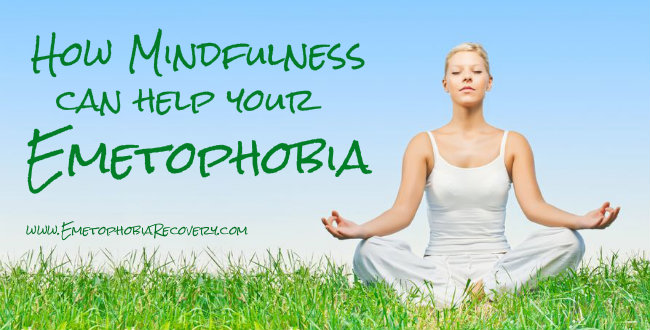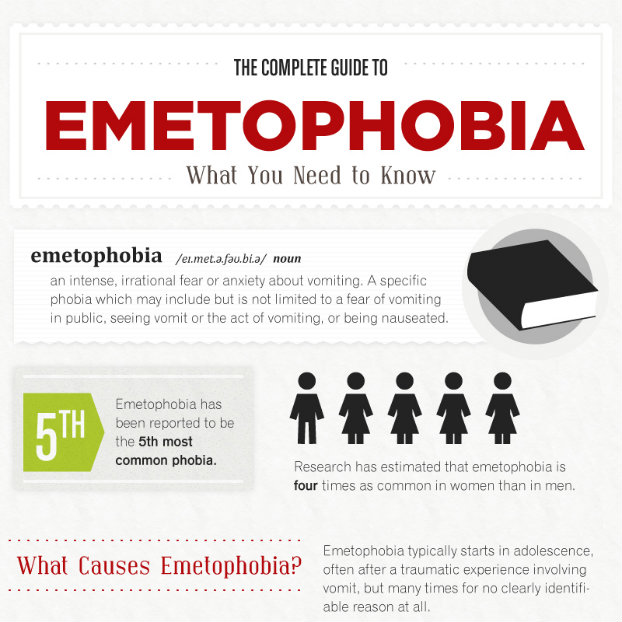 The world can be a chaotic place, with loads of stuff to do, people to see, places to go. Chances are, however, the more chaotic your schedule is, the more chaotic your brain is, the more stress you’ll succumb to and the worse your emetophobia will be. There is a better way. That way is known as mindfulness.
The world can be a chaotic place, with loads of stuff to do, people to see, places to go. Chances are, however, the more chaotic your schedule is, the more chaotic your brain is, the more stress you’ll succumb to and the worse your emetophobia will be. There is a better way. That way is known as mindfulness.
What Is Mindfulness?
Mindfulness is a supreme awareness of everything around you, being conscious of everything you touch, smell, hear, taste and see. It is paying attention and being fully aware without being judgmental. Practicing mindfulness using techniques such as those we discuss in the program we offer for emetophobia can open up a whole new way of looking at and relating to the world while you realize and enjoy your place in it. Mindfulness is cognizance of the here and now, not yesterday, not tomorrow, not sometime next week, not 10 years back.
Mindfulness is truly being in the moment.
Mindfulness vs. Meditation
While mindfulness and meditation often go hand-in-hand, they are two distinctly different things. Mindfulness teaches you to be fully aware of your surroundings with an outward focus while meditation brings an inward focus. However, the two combine quite nicely, offering a chance to quiet your mind in meditation while focusing your attention in mindfulness.
MBSR: Mindfulness Based Stress Reduction
A prime example of the power of mindfulness comes from a guy named Jon Kabat-Zinn, professor emeritus at the University of Massachusetts Medical School and founder of both UMass’s Center for Mindfulness in Medicine, Health Care and Society and its Stress Reduction Clinic.
Way back in 1979, Kabat-Zinn developed a program known as MBSR, or Mindfulness Based Stress Reduction. As the name implies, the overall goal of the program is to reduce stress through the use of mindfulness, and once stress is no longer a major component in your life, amazing things can happen.
The official MBSR program consists of eight weeks of lessons, discussions, meditation sessions, gentle stretching and daily at-home assignments aimed at increasing mindfulness. Even if you don’t run to sign up for the official MBSR course, you can benefit greatly from those amazing things that mindfulness can do for you and your emetophobia.
Mindfulness and Stress
 Mindfulness’s top prize may go for reducing stress. That’s because stress acts as fodder not only for myriad physical and mental ailments but negative behaviors that often follow. The American Psychological Association’s “Stress in America” report and Mayo Clinic offer a veritable laundry list of what stress can do to your body, mood and behavior.
Mindfulness’s top prize may go for reducing stress. That’s because stress acts as fodder not only for myriad physical and mental ailments but negative behaviors that often follow. The American Psychological Association’s “Stress in America” report and Mayo Clinic offer a veritable laundry list of what stress can do to your body, mood and behavior.
Physical anguish includes headaches, chest pain, muscle tension and pain, stomach aches, fatigue, problems sleeping and a dip in your sex drive. Mental symptoms include anxiety, restlessness, inability to focus, lack of motivation, depression, sadness and anger. Your behavior can thus include binging on food, drugs or alcohol, smoking up a storm, temper tantrums or avoiding your friends, family and even your responsibilities. Stress has also been linked to an increased risk of many diseases and disorders ranging from high blood pressure to hair loss.
What Mindfulness Can Do for Your Emetophobia
The same stress that serves up all the aforementioned woes can also have a major bearing on your emetophobia. Since stress fuels your anxiety, and anxiety is well-known for fueling fears, you may suffer heightened symptoms related to your vomit phobia.
You may find yourself increasingly nauseous or suffering frequent stomach aches. You may also begin to more fully indulge in fear-based behaviors, such as avoiding parties, certain foods or anywhere you think germs may lurk. Kicking out stress helps prevent more severe symptoms and can even help alleviate existing symptoms of your emetophobia.
Additional Mindfulness Benefits
You’ve already seen how mindfulness can decrease stress and help alleviate your emetophobia symptoms. The benefits don’t stop there. The University of Massachusetts reports that numerous studies over the years have tracked MBSR students and found many had some really good stuff to report. Those who learned to practice mindfulness enjoyed:
- Greater relaxation
- Sustained decrease in psychological symptoms
- Ongoing decrease in physical symptoms and pain
- Increased ability to manage chronic pain when pain did not subside
- Enhanced ability to cope with life’s daily ups, downs and U-turns
- More energy
- Enhanced self-esteem
- Increased enthusiasm for life
One more plug for the benefits to psychological symptoms comes from Kabat-Zinn. He published a study in The American Journal of Psychiatry back in 1992 that showed mindfulness meditation was effective for decreasing symptoms of panic and anxiety.
Additional Research Backing Benefits of Mindfulness
 Additional studies came into play, further examining mindfulness’s effect on, well, the mind. Researchers from Massachusetts General Hospital conducted a study that was published in Psychiatry Research: Neuroimaging that found mindfulness meditation could actually make changes not only to people’s way of thinking but to the brain itself.
Additional studies came into play, further examining mindfulness’s effect on, well, the mind. Researchers from Massachusetts General Hospital conducted a study that was published in Psychiatry Research: Neuroimaging that found mindfulness meditation could actually make changes not only to people’s way of thinking but to the brain itself.
The study examined brain structure MRIs of 16 participants both before and after they completed the eight-week MBSR Program. MRIs were also taken of a control group which did not participate in the MBSR Program.
Those that completed the program reported averaging about 27 minutes per day practicing mindfulness exercises, which included but was not necessarily limited to meditation. Their responses to a mindfulness questionnaire improved after the course, but the real test was aimed at finding out what happened in the MRIs of the brain.
Researchers discovered the brain’s hippocampus became denser after two months of daily mindfulness practices. The hippocampus is associated with memory, learning, self-awareness, introspection and compassion. They also discovered that study participants who reported less stress had a decrease in density of the brain’s amygdala. This region is well-known for its link to stress and anxiety. The control group that did not practice any mindfulness techniques exhibited no such changes in either brain region, illustrating that time alone was not responsible for the grey matter alterations.
A man named Richard Davidson is also in on the game. Davidson is the director of the University of Wisconsin’s Laboratory for Affective Neuroscience who used MRIs and EEGs to check out what people’s brains are doing when the people were experiencing specific moods. As one would guess, the amygdala was in high gear when folks were angry, anxious or depressed. When people were feeling energized, upbeat and enthusiastic, the right-sided amygdala was pretty dormant. A different region of the brain was active, namely the one in the left prefrontal cortex.
This research allowed Davidson to examine numerous brain scans over time and find you could gauge a person’s mood by what was going in the person’s brain. He also discovered most folks had a mixture of moods on a varying basis, but those who tended to have more right-sided amygdala activity tended to have more anguish. Those with more activity in the left prefrontal cortex were typically happier and more positive.
Davidson stumbled across a chance to test the left-right ratio on 175 people at a seminar, including a Tibetan lama. It was discovered, perhaps not surprisingly, that the monk had the highest left ratio of the bunch, indicating the index for mood may not be set in stone and could be changed with a bit of practice.
Davidson tested the theory by pairing up with Kabat-Zinn for a study that examined the brains of employees at high-pressure jobs in the biotech industry before and after eight weeks of mindfulness practice. Their brains, too, showed a switch to more left activity and less in the right-sided amygdala.
“In mindfulness, people learn to monitor their moods and thoughts and drop those that might spin them toward distress,” The New York Times says in an article reporting on the Davidson and Kabat-Zinn study.
One more perk the article pointed out was mindfulness’s effect on physical health. It appeared to boost the immune system. Davidson said studies have suggested mindfulness practitioners exposed to the flu virus had less severe symptoms than those who did not practice mindfulness techniques.
“The greater the leftward shift in the emotional set point, the larger the increase in the immune measure,” the article said.
Greater immunity and less chance of suffering from a virus is yet one more mindfulness benefit for emetophobia.
How to Get Mindful – Right Now!
 As mentioned earlier, you don’t need an official course to practice mindfulness, you can start right now with a few simple changes in the way you normally go through your day. Instead of hustling, bustling, rushing and knocking things over in your normal whirling dervish way – STOP. Breathe. And just be.
As mentioned earlier, you don’t need an official course to practice mindfulness, you can start right now with a few simple changes in the way you normally go through your day. Instead of hustling, bustling, rushing and knocking things over in your normal whirling dervish way – STOP. Breathe. And just be.
Be mindful with your breath. Concentrating on and calming your breath is one of the easiest and most immediate ways to focus and calm your mind. You can read more on its power in our Emetophobics Guide to Breathing Your Way Through Anxiety, and you can also correlate it with your mindfulness. Exhale deeply through your mouth. Feel the breath move out through your lungs, between your lips. Feel your shoulders relax and your stomach go hollow. Now inhale deeply through your nose. Feel your breath expand your nostrils, fill up your lungs, lift up your ribs and shoulders.
Keep breathing mindfully for several minutes, just paying attention to your bodily sensations as you breathe in an out in a slow, steady and peaceful manner. Now keep this technique filed your mind and pull it out to use it anytime stress, anxiety or your scurrying threaten to damper your serenity.
Be mindful in your tasks. Try applying mindfulness to any and every task you do throughout the day. Be mindful while making your bed, taking a shower, cleaning the toilet, walking down the street. Any activity you typically do without thinking is fair game, as are the activities you do while thinking “this stinks.”
Rather than making your bed with a scowl and hating how the sheets always come untucked, try making it with a neutral mind and really paying attention to the motion of the activity. Feel the softness of the sheets beneath your hands, the strain of your body as you tug at the mattress, the fluff of the stuffing as you plump up the pillow. Noticing the sounds, smells and sights of making your bed can transform a mundane task into a mindfulness art form.
Find mindfulness times whenever you get a lull. On hold on the phone? Waiting in line at the grocery? Stuck at an infinite red light? Don’t get frustrated. Get mindful. Notice the sights, smells, sounds, sensations of everything around you as you wait. Inserting little pockets of mindfulness throughout your day can slow down your racing head and let you move forward with less anxiety and more serenity.
Wake up to a bout of mindfulness. Rather than lunging out of bed to the screaming alarm, shut the alarm gently and spend a moment or two in mindfulness. Open your eyes and take in everything around you. Feel the covers above your body, the pillow beneath your head. Breathe deeply and notice any smells and sounds, perhaps the aroma freshly brewed coffee, or whatever else awaits you to start your day.
Be mindful of your thoughts without trying to control them. Psychologist Marsha Lucas likens our thoughts to wandering puppies. They romp. They play. They poke their noses around out of curiosity. Rather than grabbing or stopping or scolding the puppy, let it wander where it may.
Observe how your thought process works, how ideas are linked together or how your thoughts can arouse emotions. Watching your thought process in such a mindful manner can be a great help for emetophobia when your thoughts start to go galloping toward anxiety and stress. Rather than jumping on the puppy’s back and letting your thoughts take you on a stressful ride, simply observe without judgment; just watch.
Including even a little bit of mindfulness into your daily life can leave you with a lot of rewards. A reduction in stress levels and vomit fears are just the beginning. You may also find being more aware of the world and your place in it makes life more enjoyable overall.
SOURCES:
- http://www.umassmed.edu/cfm/stress/index.aspx
- http://psychcentral.com/blog/archives/2012/06/09/7-easy-ways-to-be-mindful-every-day/
- http://www.nytimes.com/2003/02/04/health/behavior-finding-happiness-cajole-your-brain-to-lean-to-the-left.html
- http://www.massgeneral.org/about/pressrelease.aspx
- http://www.massgeneral.org/bhi/research/mind_body_neuroimaging.aspx
- http://zenhabits.net/the-mindfulness-guide-for-the-super-busy-how-to-live-life-to-the-fullest/
- http://www.mayoclinic.com/health/stress-symptoms/SR00008_D
- http://www.apa.org/news/press/releases/stress/national-report.pdf
Photo Credit: RelaxingMusic, TomConger, ww.flickr.com/photos/44461337@N06/4662954455/”>gtall1





